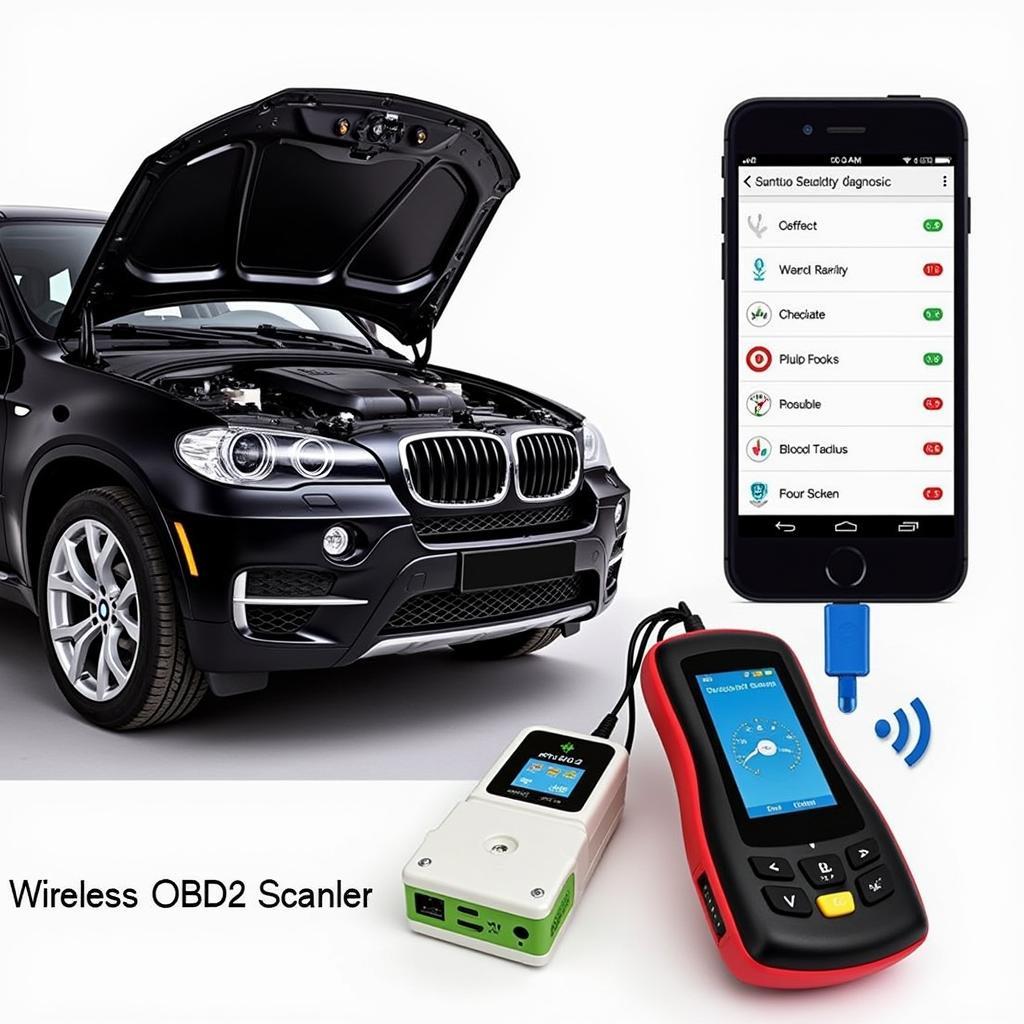Owning a BMW X5 is a statement. It says you appreciate luxury, performance, and cutting-edge technology. But even the most sophisticated machines can run into problems. That’s where a BMW X5 OBD2 app comes in, providing a window into your car’s soul – or at least its engine control unit (ECU). This guide dives deep into the world of OBD2 apps for your X5, empowering you to understand, diagnose, and even fix issues yourself.
 BMW X5 Connected to OBD2 Scanner
BMW X5 Connected to OBD2 Scanner
Understanding Your X5’s Brain: The OBD2 System
Before we delve into the world of apps, let’s demystify the OBD2 system. Short for On-Board Diagnostics, OBD2 is a standardized system present in most cars manufactured after 1996, including your beloved X5. It acts like your car’s central nervous system, monitoring various components and reporting any malfunctions.
The system achieves this through a network of sensors placed throughout your vehicle. These sensors constantly collect data on everything from engine speed and temperature to emissions and fuel efficiency. This data is then relayed to the ECU, the brains of your X5’s operation.
Enter the OBD2 App: Your Pocket-Sized Mechanic
Now, imagine having direct access to this wealth of information right from your smartphone. That’s precisely what a BMW X5 OBD2 app allows you to do. By connecting your phone wirelessly to the OBD2 port (usually located under the dashboard), you can unlock a treasure trove of insights about your X5’s health and performance.
Choosing the Right OBD2 App for Your X5
With a plethora of OBD2 apps available, choosing the right one can be overwhelming. Here are some factors to consider:
- Compatibility: Ensure the app explicitly states compatibility with BMW vehicles, particularly the X5 model year you own.
- Features: Basic apps display diagnostic trouble codes (DTCs), while advanced options offer real-time data monitoring, performance tracking, and even coding capabilities.
- User Interface: A user-friendly interface is crucial for navigating the app easily and understanding the information presented.
- Reviews and Ratings: Always check user reviews and ratings on app stores to gauge the app’s reliability, accuracy, and customer support.
Unlocking the Power of Diagnostics: What Can a BMW X5 OBD2 App Do?
The capabilities of OBD2 apps extend far beyond simply reading and clearing check engine lights. Let’s explore some of the key features:
1. Diagnose Engine Problems
This is where OBD2 apps truly shine. The app retrieves and decodes DTCs stored in your X5’s ECU. Instead of seeing a cryptic code, you’ll get a clear description of the issue, such as “Oxygen Sensor Malfunction” or “Misfire Detected.”
2. Monitor Real-Time Data
Want to see your X5’s performance live in action? Many apps display real-time data from various sensors, including:
- Engine RPM
- Coolant Temperature
- Speed
- Fuel Pressure
- Oxygen Sensor Readings
Monitoring this data can help you identify potential issues before they escalate and even optimize your driving for better fuel efficiency.
3. Analyze Fuel Economy
Curious about your X5’s fuel consumption? OBD2 apps can track your fuel economy over time, helping you understand how driving habits and maintenance impact your mileage.
4. Track Performance Metrics
For the performance enthusiast, some apps allow you to record acceleration times, braking distances, and even horsepower and torque figures.
5. Customize Vehicle Settings (Coding)
This advanced feature lets you tweak certain vehicle settings, such as automatic door locking, daytime running lights, and even the responsiveness of the throttle. However, coding should be approached with caution and ideally performed by experienced individuals.
Common BMW X5 Issues an OBD2 App Can Help Diagnose
From minor glitches to more serious problems, an OBD2 app can help pinpoint the root cause of a variety of issues, including:
- Check Engine Light: The most common reason for using an OBD2 app, it helps determine if the issue is emissions-related, engine-related, or something else.
- Rough Idle: The app can identify problems with spark plugs, ignition coils, or vacuum leaks.
- Poor Fuel Economy: Monitor oxygen sensor data, fuel trim values, and other relevant parameters.
- Transmission Problems: While not as comprehensive as engine diagnostics, some apps can detect transmission-related codes.
- Emissions System Issues: Check for faulty oxygen sensors, catalytic converters, or EVAP system leaks.
Beyond Diagnostics: The Future of OBD2 Apps
The evolution of OBD2 apps doesn’t stop at diagnostics. With advancements in connected car technology, we can expect to see features like:
- Predictive Maintenance: Apps analyzing real-time data to predict potential component failures, allowing for proactive maintenance.
- Remote Diagnostics: Imagine sharing your car’s diagnostic data with your mechanic remotely for quicker diagnosis and repair estimates.
- Enhanced Security Features: Some apps are incorporating security features like GPS tracking and tamper alerts to deter theft.
Conclusion
A BMW X5 OBD2 app isn’t just a tool; it’s an investment in understanding, maintaining, and enhancing your driving experience. By providing a direct line of communication with your X5’s intricate systems, these apps empower you to stay ahead of potential issues, optimize performance, and enjoy the peace of mind that comes with knowing your prized possession is in top shape. So, embrace the power of technology, empower yourself with knowledge, and unlock the full potential of your BMW X5.
